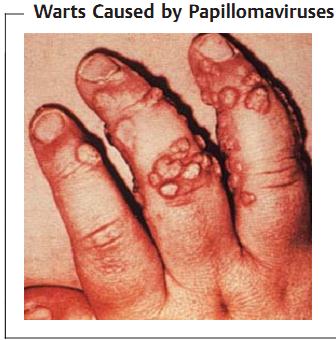


 النبات
النبات
 الحيوان
الحيوان
 الأحياء المجهرية
الأحياء المجهرية
 علم الأمراض
علم الأمراض
 التقانة الإحيائية
التقانة الإحيائية
 التقنية الحيوية المكروبية
التقنية الحيوية المكروبية
 التقنية الحياتية النانوية
التقنية الحياتية النانوية
 علم الأجنة
علم الأجنة
 الأحياء الجزيئي
الأحياء الجزيئي
 علم وظائف الأعضاء
علم وظائف الأعضاء
 الغدد
الغدد
 المضادات الحيوية
المضادات الحيوية|
Read More
Date: 29-10-2015
Date: 19-11-2015
Date: 18-11-2015
|
Papillomaviruses
The over 70 viral types in the genus Papillomavirus are all involved in the etiology of benign tumors such as warts and papillomas, as well as malignancies, the latter mainly in the genital area (cervical carcinoma). These organisms cannot be grown in cultures. Diagnosis therefore involves direct detection of the viral genome and histological analysis. Serology is less important in this group.
Pathogens. The papillomaviruses have a diameter of 55 nm and contain an 8 kbp dsDNA genome. There are two distinct regions within the circular genome: one that codes for the regulator proteins produced early in the replication cycle and another that codes for the structural proteins synthesized later. Over 70 papillomavirus types have been described to date, all of which induce either benign or malignant tumors in natural or experimental hosts.
Pathogenesis and clinical picture. Papillomaviruses infect cells in the outer layers of the skin and mucosa and cause various types of warts by means of local cell proliferation (Fig. 1). Specific virus types correlate with specific pathohistological wart types. Plantar and vulgar warts, flat juvenile warts, and juvenile laryngeal papillomas apparently always remain benign. By contrast, the genital warts caused by types 6 and 11 (condylomata acuminata) can show carcinomatous changes. Of all papillomavirus-caused cervical dysplasias, 50% contain human papillomavirus (HPV) 16 and 20% HPV 18.
All wart viruses induce primary proliferation of the affected cells with large numbers of viruses found in the cell nuclei. Whether a malignant degeneration will take place depends on the cell and virus type involved, but likely on the presence of cocarcinogens as well. In carcinomas, the viral DNA is found in integrated form within the host-cell genome, whereas in premalignant changes the viral genomes are found in the episomal state. Papillomaviruses possess oncogenes (E5, E6, and E7 genes) that bind the products of tumor suppressor genes: E6 binds the p53 gene product, E7 the Rb gene product.
Diagnosis. Human papillomaviruses cannot be cultivated in vitro. They are detected and identified by means of histological analysis and, in malignancies in particular, by means of in-situ hybridization. Antibody assay results have a low significance level and these procedures are not standard routine.
Epidemiology and prevention. Since viruses are produced and accumulate in wart tissues, papillomaviruses are transmissible by direct contact. Warts can also spread from one part of the body to another (autoinoculation). A certain level of prophylactic protection can be achieved with hygienic measures.

Fig .1.



|
|
|
|
دراسة يابانية لتقليل مخاطر أمراض المواليد منخفضي الوزن
|
|
|
|
|
|
|
اكتشاف أكبر مرجان في العالم قبالة سواحل جزر سليمان
|
|
|
|
|
|
|
المجمع العلمي ينظّم ندوة حوارية حول مفهوم العولمة الرقمية في بابل
|
|
|